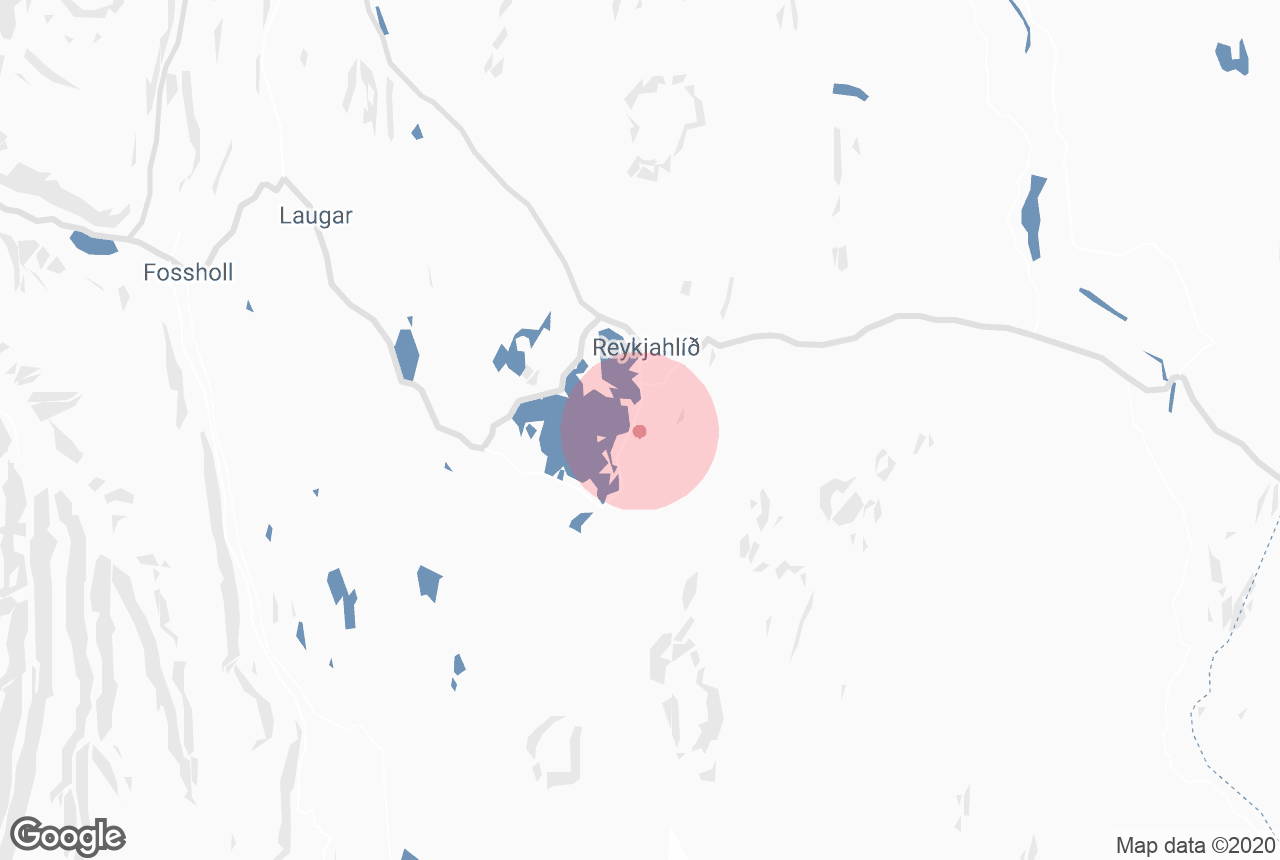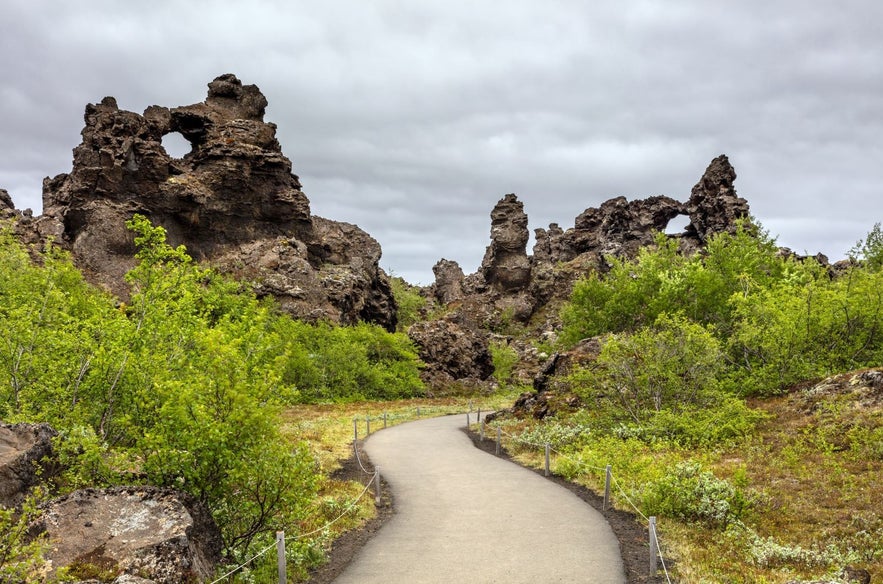
Dimmuborgir, often called the “Dark Fortress,” is an expansive lava field located near Lake Myvatn in Iceland. Shrouded in mystery and steeped in centuries of folklore, it promises an unforgettable journey for those brave enough to explore its secrets.
Dimmuborgir is a fascinating geological wonder and offers visitors the perfect combination of natural beauty and intriguing folklore. Easily accessible from nearby towns, Dimmuborgir is a must-see destination for travelers exploring the region.
To get to Dimmuborgir, it’s a scenic 33-mile (53-kilometer) drive from Akureyri, the largest town in North Iceland.
If you’re traveling from Reykjavik, the trip is about 176 miles (283 kilometers). For those looking for more flexibility, renting a car is a great option.
There are several Lake Myvatn tours and Diamond Circle tours available that include Dimmuborgir as part of the itinerary, offering the convenience of a guided experience.
Once you arrive, you’ll find a range of walking paths that wind through the area, allowing you to explore the towering lava formations and deep caverns. Some trails are wheelchair accessible, ensuring that everyone can enjoy the unique landscape. Read on for more about this incredible volcanic site.
Key Takeaways
-
Dimmuborgir, known as the "Dark Fortress," is a volcanic landscape in Iceland, rich in both geological wonders and folklore.
-
The area was formed over 2,300 years ago during a volcanic eruption, creating its unique lava formations and deep caverns.
-
According to Icelandic folklore, Dimmuborgir is home to the Yule Lads, mischievous trolls who are a key part of Icelandic Christmas traditions.
-
Dimmuborgir is a year-round destination, with summer offering ideal hiking conditions and winter providing a magical atmosphere with potential northern lights sightings.
-
Nearby attractions include Akureyri, Iceland's "Capital of the North," and Lake Myvatn, home to stunning landscapes, geothermal hot springs, and more volcanic wonders.
The Unique Dimmuborgir Lava Formations
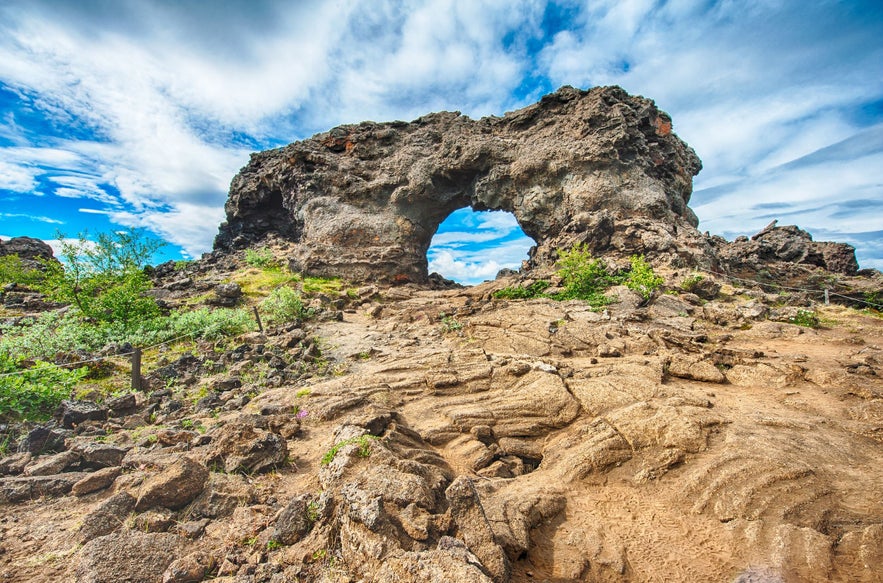 Over 2,000 years ago, the pressure of magma beneath the Icelandic surface built into a volcanic eruption that spewed hot gases, ash, and lava into the air. The landscape changed forever. This eruption, one of many in Iceland’s geologic history, sent lava flowing across the land until it reached a lake. Water turned to steam, rapidly cooling and shattering the molten stone.
Over 2,000 years ago, the pressure of magma beneath the Icelandic surface built into a volcanic eruption that spewed hot gases, ash, and lava into the air. The landscape changed forever. This eruption, one of many in Iceland’s geologic history, sent lava flowing across the land until it reached a lake. Water turned to steam, rapidly cooling and shattering the molten stone.
The result of this violent event produced an otherworldly landscape of towers and deep caverns, unlike anything else on Earth. This is Dimmuborgir.
Dimmuborgir serves as an important nesting site for various bird species, including falcons. The combination of rugged terrain and a peaceful environment makes it an ideal habitat for these birds. As you explore, be sure to stay on designated paths to avoid disturbing the wildlife and protect the delicate ecosystem.
Iconic Landmarks and Scenic Hikes in Dimmuborgir
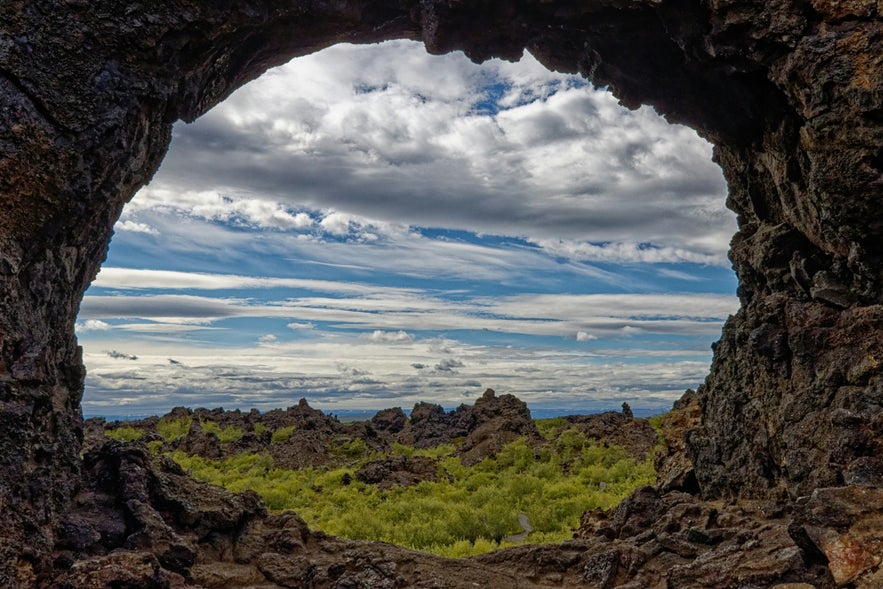 Dimmuborgir isn’t just a captivating geological site; it’s also home to a range of fascinating attractions and hiking trails that make it a must-visit spot in Iceland. Some of the paths in Dimmuborgir are wheelchair accessible, providing the opportunity for all visitors to experience the beauty of the lava formations.
Dimmuborgir isn’t just a captivating geological site; it’s also home to a range of fascinating attractions and hiking trails that make it a must-visit spot in Iceland. Some of the paths in Dimmuborgir are wheelchair accessible, providing the opportunity for all visitors to experience the beauty of the lava formations.
For those seeking more adventure, longer trails wind through challenging volcanic terrain, offering deep exploration of the landscape.
Kirkjan—The Lava Church Formation
 One of Dimmuborgir’s most iconic features is the Lava Church (Kirkjan) formation, a lava tube structure with a dome-like ceiling that resembles the inside of a grand cathedral. The eerie, gothic architecture of this formation makes it one of the most photographed sites in the area.
One of Dimmuborgir’s most iconic features is the Lava Church (Kirkjan) formation, a lava tube structure with a dome-like ceiling that resembles the inside of a grand cathedral. The eerie, gothic architecture of this formation makes it one of the most photographed sites in the area.
To reach the Church formation, take the Church Route (Kirkjuhringurinn), a 1.5-mile (2.4-kilometer) trail that takes you directly to the formation.
This easy-to-moderate hike offers breathtaking views along the way and takes about an hour to complete. It's perfect for those wanting to get up close to the Church formation and enjoy Dimmuborgir’s otherworldly landscape.
Yule Lads’ Cave
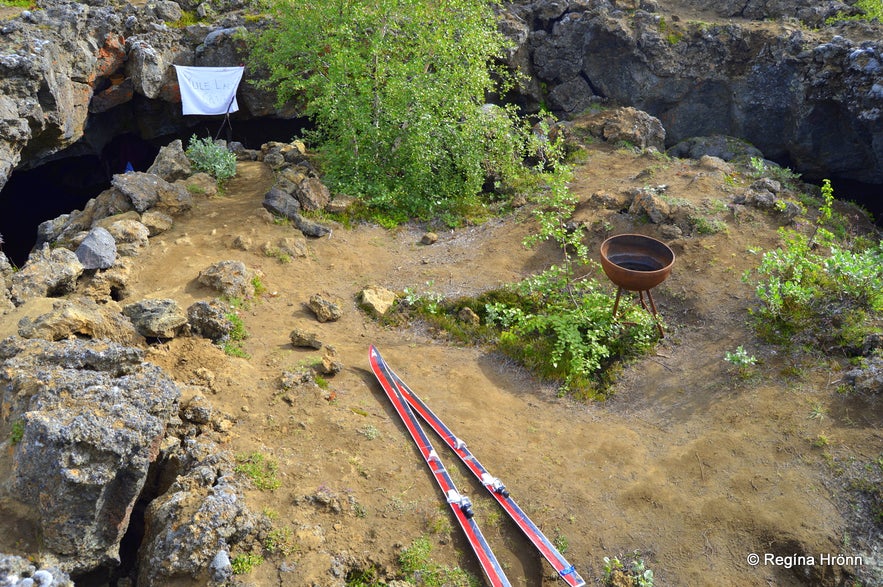
The cave of the Yule Lads—Jólasveinahellirinn
According to Icelandic folklore, Dimmuborgir is the home of the Yule Lads, a group of mischievous trolls who appear one by one in the 13 nights leading up to Christmas. The Yule Lads’ Cave, said to be their hideout, adds an extra layer of magical charm to Dimmuborgir.
To visit the cave, follow one of the trails that lead deeper into the heart of the lava formations. The Yule Lads’ Cave is located off the main paths, so keep an eye out for signs directing you toward this mystical spot.
While it’s not as well-marked as the Church formation, it’s a must-see for fans of Icelandic Christmas traditions.
Other Dimmuborgir Trails
In addition to the Church Route, there are several other Iceland hiking trails in Dimmuborgir for those looking for a longer hike or more diverse terrain. These trails vary in difficulty, from easy walks to more challenging routes that will lead you through the heart of the formations, offering a deeper exploration of this mystical site.
You can also hike to the beautiful Grjotagja Cave, another Game of Thrones filming location in the region.
Whether you’re looking for a leisurely stroll or a more challenging adventure, Dimmuborgir’s hiking trails allow visitors to fully immerse themselves in the site’s natural beauty and eerie landscape.
Dimmuborgir’s Folklore & Legends—Tales From the Dark Fortress
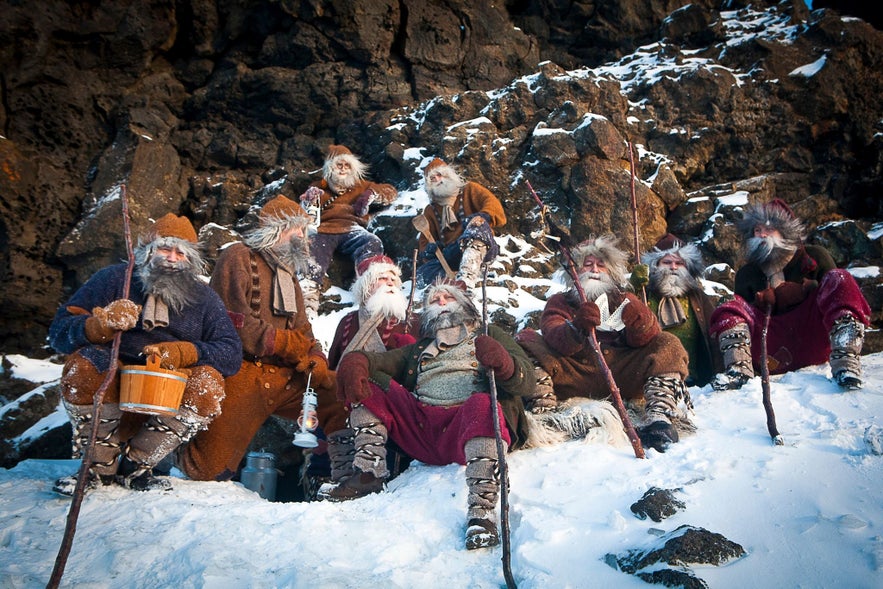
Photo from Visit Mývatn. The Yule Lads at the Dimmuborgir lava field by Lake Myvatn.
In Icelandic Christmas tradition, the caves of Dimmuborgir are said to be the homes of trolls—mysterious, fearsome creatures who lurk in the shadows. Among the most notorious of these is Grýla, a half-troll, half-ogre known for her insatiable hunger for children who misbehave during the Christmas season.
With her giant pet cat that feasted on misbehaving youngsters who didn’t receive new clothes for Christmas, Grýla’s legend served as both a warning and a way to encourage children to complete their seasonal chores, like knitting and sewing.
Grýla, along with her lazy husband Leppalúði, raised 13 mischievous sons in Dimmuborgir, now famously known as the Yule Lads. Each of these trolls had a distinct personality and a peculiar habit that earned them their names. These habits typically revolved around stealing Christmas treats or creating mischief in homes during the festive period.
For example, Sheep-Colt Clod would harass livestock; Skyr-Gobbler would steal and savor the house’s supply of skyr (Iceland’s yogurt-like treat); and Window-Peeper would peer into windows, seeking items to pilfer.
These trolls, part of Icelandic storytelling meant to keep children safe from wandering into the perilous winter nights, have evolved over the centuries. Originally terrifying figures, the Yule Lads have transformed into playful tricksters in modern times. They now wear Santa costumes and even bring gifts, though Skyr-Gobbler still can’t resist a taste of that delicious dairy treat!
As Christianity spread in Iceland, unique stories about Dimmuborgir began to emerge, adding a new layer of folklore to the area’s rich history. The stark landscape led many to believe it was the very spot where Satan had landed when cast from heaven. The eerily dark lava formations were thought to be the catacombs of hell itself, adding to the sense of mystique surrounding this volcanic fortress.
From Myth to Metal—Dimmuborgir's Influence in Pop Culture
Dimmuborgir has not only captivated locals with its dark history and folklore but also made its mark in popular culture. Game of Thrones famously featured the site as the location where Mance Rayder held his wildling army, setting the stage for some of the show’s dramatic moments. This makes it a key stop on Game of Thrones tours.
The twisted lava formations and haunting atmosphere make Dimmuborgir an ideal setting for stories of fantasy, mystery, and the supernatural. That's why it has been used in several other films and TV shows.
Additionally, the popular Norwegian black metal band Dimmu Borgir takes its name from this mystical location. The band, known for its dark, melodic music, draws inspiration from the eerie landscapes of Dimmuborgir, further cementing the site's place in both folklore and modern cultural imagination.
This connection to pop culture, combined with its unique history, has brought a new wave of visitors. Many come to see where their favorite scenes were filmed and to experience the magic and mystery of Dimmuborgir firsthand.
How To Get to Dimmuborgir
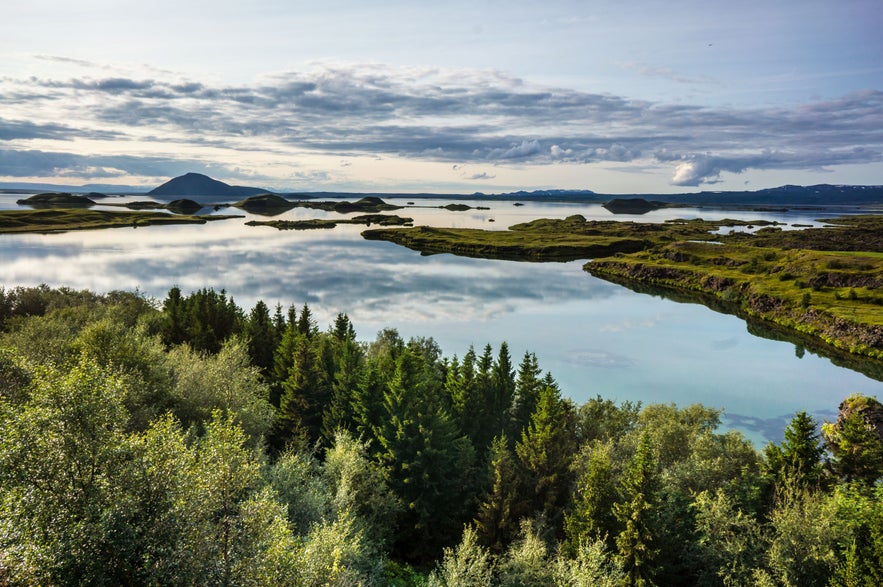 Dimmuborgir is located in the Lake Myvatn region of northern Iceland, making it easily accessible for visitors traveling along the Ring Road. It’s 33 miles (53 kilometers) from the town of Akureyri, Iceland’s second largest city, and 176 miles (283 kilometers) from Reykjavik.
Dimmuborgir is located in the Lake Myvatn region of northern Iceland, making it easily accessible for visitors traveling along the Ring Road. It’s 33 miles (53 kilometers) from the town of Akureyri, Iceland’s second largest city, and 176 miles (283 kilometers) from Reykjavik.
If you're coming from Reykjavik, head northeast on the Ring Road (Route 1) toward Akureyri. Turn off onto Route 845 toward Lake Myvatn, and you’ll find Dimmuborgir just a short drive away from the lake. There are clear signs along the route to guide you to the site.
For those relying on public transport, bus route NR 56 from Akureyri to Lake Myvatn is available, but renting an affordable car provides more flexibility and allows you to explore the region at your own pace.
There’s also a designated parking area right by the entrance, where visitors can park and begin their exploration of this mystical site.
Exploring Dimmuborgir—Guided & Self-Drive Tours
 Dimmuborgir is a captivating destination for travelers seeking both natural beauty and cultural intrigue. Whether you prefer the convenience of guided tours or the flexibility of self-driving, there are options to suit every traveler's preference.
Dimmuborgir is a captivating destination for travelers seeking both natural beauty and cultural intrigue. Whether you prefer the convenience of guided tours or the flexibility of self-driving, there are options to suit every traveler's preference.
Day Trips to Dimmuborgir
Discover the wonders of Dimmuborgir and the Lake Myvatn region with guided day trips. These tours offer a convenient way to explore Iceland's geological marvels, including Dimmuborgir's unique lava formations, the surrounding landscapes, and geothermal hot springs, all while being led by knowledgeable local guides.
-
Lake Myvatn Sightseeing & Hot Springs Tour From Akureyri – Explore Dimmuborgir’s unique lava formations, relax in the Myvatn Nature Baths, and visit iconic sites like Godafoss Waterfall and Hverfjall Crater.
-
8-Hour Tour of Waterfalls, Lake Myvatn, & Geothermal Nature Baths – Visit Godafoss Waterfall, Dimmuborgir, and the Myvatn Nature Baths, with plenty of time to take in the area’s volcanic landscape.
-
Sightseeing Tour From Akureyri | Waterfalls & Myvatn Nature Baths – Experience the stunning Myvatn region, including visits to Godafoss Waterfall, Dettifoss, Selfoss, and Grjotagja Cave. This all-in-one tour also includes a relaxing visit to the Myvatn Nature Baths, often referred to as the “Blue Lagoon of the North.”
Multi-Day Tours to Dimmuborgir
For a deeper dive into Iceland’s natural beauty, consider a guided multi-day tour. These immersive tours allow you to explore the full range of Iceland's landscapes, from the rugged South Coast to the volcanic North. With a professional guide, you won't miss any of the country's iconic landmarks and hidden gems.
-
6-Day Guided Small-Group Tour of the Ring Road – Take a comprehensive 6-day winter journey around Iceland's Ring Road and discover Iceland’s cultural landmarks and natural wonders, including opportunities for glacier hiking and ice caving.
-
8-Day Guided Tour of the Ring Road – Experience an unforgettable 8-day trip around Iceland’s Ring Road, visiting iconic attractions such as the Golden Circle, South Coast waterfalls, and Dimmuborgir. At Dimmuborgir, you can explore the unique volcanic landscape and learn about local folklore.
-
6-Day Ring Road Tour With Summer Glacier Hike and Winter Ice Caving – This 6-day guided small-group tour offers an in-depth exploration of Iceland’s Ring Road. Experience highlights such as the Golden Circle, South Coast waterfalls, Jokulsarlon Glacier Lagoon, Lake Myvatn, and Dimmuborgir.
Self-Drive Tours to Dimmuborgir
For travelers who prefer flexibility and the freedom to explore at their own pace, self-drive tours are an excellent choice. Here are some self-drive packages that include Dimmuborgir in their itineraries.
-
7-Day Self-Drive Tour of the Ring Road – Embark on a week-long journey around Iceland's Ring Road, experiencing highlights such as the Golden Circle, South Coast waterfalls, Jokulsarlon Glacier Lagoon, Lake Myvatn, and Snaefellsnes Peninsula.
-
10-Day Self-Drive Tour of the Complete Ring Road of Iceland With Top Attractions & Snaefellsnes – Explore the complete Ring Road with this 10-day adventure, including a visit to Dimmuborgir, Lake Myvatn, Jokulsarlon Glacier Lagoon, and more, ensuring a comprehensive experience of Iceland's natural beauty.
-
Epic 2-Week Self-Drive Tour of the Ring Road of Iceland & the Westfjords – Discover the beauty of Iceland on a 14-day journey around the Ring Road and into the remote Westfjords, where hidden gems and dramatic landscapes await. From iconic landmarks like the Golden Circle and Jokulsarlon Glacier Lagoon to the serene fjords of the Westfjords, this self-drive tour offers a comprehensive exploration of Iceland’s diverse wonders.
Nearby Attractions—Lake Myvatn, the Diamond Circle, & Akureyri
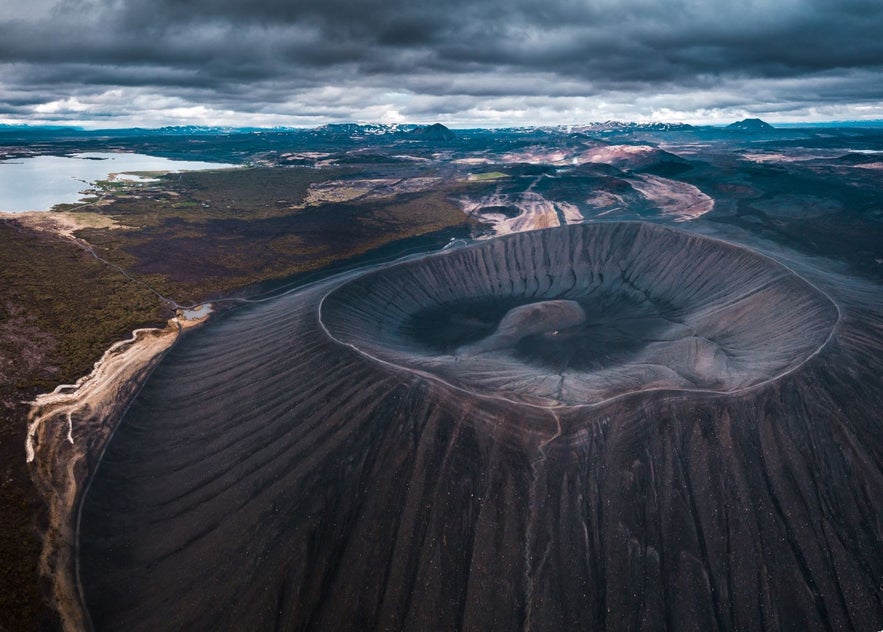 Just a short drive from Dimmuborgir, the surrounding areas of Lake Myvatn, the Diamond Circle, and Akureyri offer a wealth of natural wonders and cultural gems. From volcanic landscapes and geothermal springs to charming towns and historical landmarks, these nearby destinations are perfect for extending your adventure in North Iceland.
Just a short drive from Dimmuborgir, the surrounding areas of Lake Myvatn, the Diamond Circle, and Akureyri offer a wealth of natural wonders and cultural gems. From volcanic landscapes and geothermal springs to charming towns and historical landmarks, these nearby destinations are perfect for extending your adventure in North Iceland.
Lake Myvatn
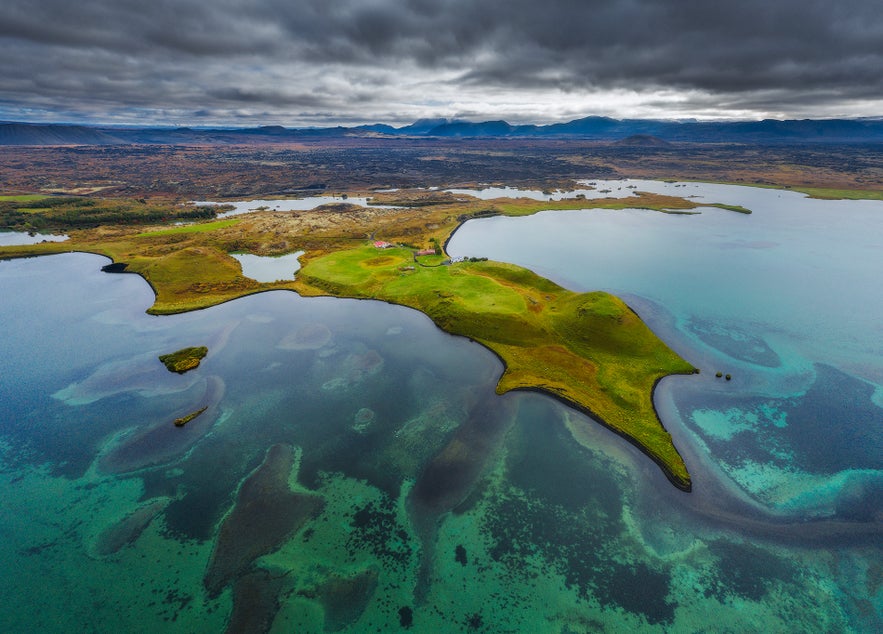 Around an hour's drive from Akureyri, Lake Myvatn and its surrounding area offer a wealth of natural wonders. The Dimmuborgir Lava Formations are among the most striking features, often referred to as the "Dark Castles" due to their otherworldly appearance.
Around an hour's drive from Akureyri, Lake Myvatn and its surrounding area offer a wealth of natural wonders. The Dimmuborgir Lava Formations are among the most striking features, often referred to as the "Dark Castles" due to their otherworldly appearance.
For a panoramic view of the region, hike to the top of Hverfjall Crater, a massive volcanic crater that offers sweeping vistas of the lake and the surrounding landscape.
Afterwards, unwind at the Myvatn Nature Baths, known as the "Blue Lagoon of the North," where you can soak in the soothing geothermal waters while surrounded by volcanic scenery.
Not far from the baths is Grjotagja Cave, a small lava cave with a thermal spring inside, which gained fame as a filming location for Game of Thrones. Lastly, stroll along the Hofdi Peninsula, where you’ll find unique lava formations, trees, and scenic walking paths perfect for bird watching and enjoying the peaceful surroundings.
These attractions near Dimmuborgir offer a perfect mix of natural beauty, geological wonders, and cultural experiences, making them essential stops when exploring the North of Iceland.
The Diamond Circle
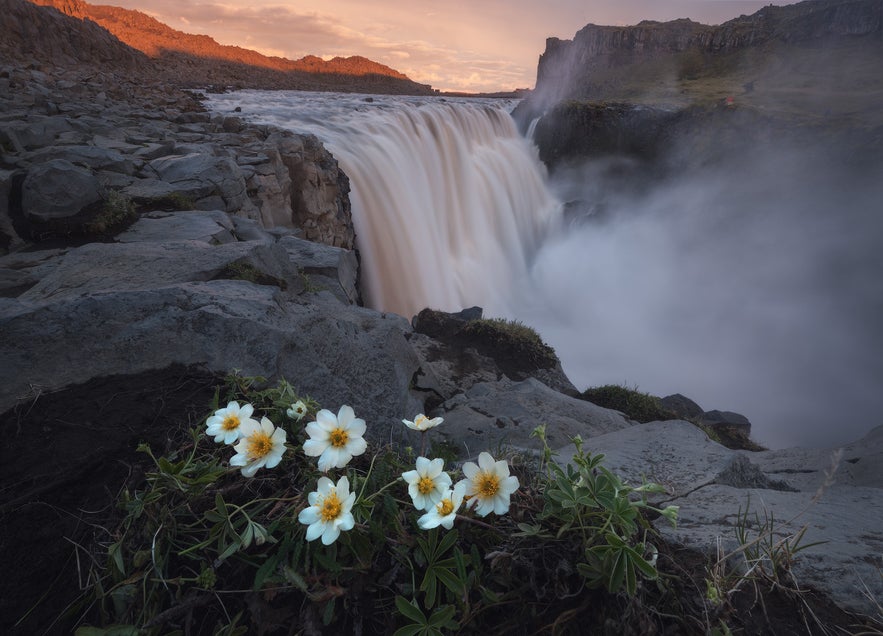
The Diamond Circle is one of Iceland’s most popular tourist routes, encompassing some of the country’s most stunning and diverse natural wonders. Starting in the town of Akureyri, this route takes you through the breathtaking landscapes of North Iceland, including the majestic Godafoss Waterfall, the dramatic Lake Myvatn region, and the otherworldly Dimmuborgir Lava Formations.
Along the way, you’ll encounter Husavik, often called the whale-watching capital of Iceland, and Dettifoss, Europe’s most powerful waterfall. The Diamond Circle offers a perfect combination of geothermal wonders, volcanic landscapes, and rich wildlife, making it an ideal route for nature lovers and adventure seekers alike. Whether you’re exploring by car or joining a guided tour, the Diamond Circle is a must-see for anyone visiting North Iceland.
Akureyri
 Often called the "Capital of North Iceland," Akureyri is a charming town with a blend of cultural richness and natural beauty. Visitors can explore the Akureyri Botanical Garden, one of the northernmost botanical gardens in the world. It's home to over 7,000 plant species, including 400 native Icelandic plants.
Often called the "Capital of North Iceland," Akureyri is a charming town with a blend of cultural richness and natural beauty. Visitors can explore the Akureyri Botanical Garden, one of the northernmost botanical gardens in the world. It's home to over 7,000 plant species, including 400 native Icelandic plants.
Another must-see is Akureyri Church, an iconic structure designed by Guðjón Samúelsson. The church is known for its striking architecture and beautiful stained glass windows that tell the story of Iceland’s ecclesiastical history.
If you're a fan of wildlife, the surrounding Eyjafjordur Fjord also serves as a prime base for spotting marine life. You can book this Akureyri whale-watching tour, where you might catch sight of humpback, minke, or orca whales.
FAQs About Dimmuborgir Lava Formations
Have questions about visiting Dimmuborgir? Below, we've answered some of the most common inquiries to help you plan your trip and make the most of your experience at this mystical Icelandic landmark.
1. When is the best time to visit Dimmuborgir?
Dimmuborgir is a year-round destination, but the best time to visit depends on your preferences.
-
Summer offers milder weather and long daylight hours, perfect for hiking and exploring.
-
Winter provides a magical atmosphere with potential northern lights sightings and snow-covered landscapes. Be aware that winter conditions can bring heavy snow, and 4x4 vehicles are recommended. There may be temporary road closures due to snow and ice, so always double-check road conditions.
2. Are there entry fees to Dimmuborgir?
There is no entry fee to visit Dimmuborgir. The site is open to the public and parking is free, allowing visitors to explore the formations and trails freely.
3. Is food, water, and restroom access available at Dimmuborgir?
Yes, Dimmuborgir offers basic facilities, including a cafe and restrooms near the parking area. However, it’s recommended to bring your own water and snacks, especially if you plan to hike the longer trails or visit during off-peak seasons when services may be limited.
4. How long does it take to explore Dimmuborgir?
The time it takes to explore Dimmuborgir depends on your interests and hiking pace. The main attractions, including the Lava Church Route, can be seen in about 1-2 hours. For those wanting to explore more trails and enjoy the full experience, a visit may last up to 3-4 hours.
5. Can I climb the lava formations in Dimmuborgir?
While the Dimmuborgir Lava Formations are fascinating and offer an otherworldly landscape, climbing them is discouraged to protect the environment and your safety.
The formations can be fragile, and staying on marked trails ensures you enjoy the site while preserving its integrity.
6. How do you pronounce Dimmuborgir?
Dimmuborgir is pronounced "DIM-moo-borg-eer," with the emphasis on the first syllable.
Into the Heart of Dimmuborgir—Iceland’s Dark Fortress Awaits
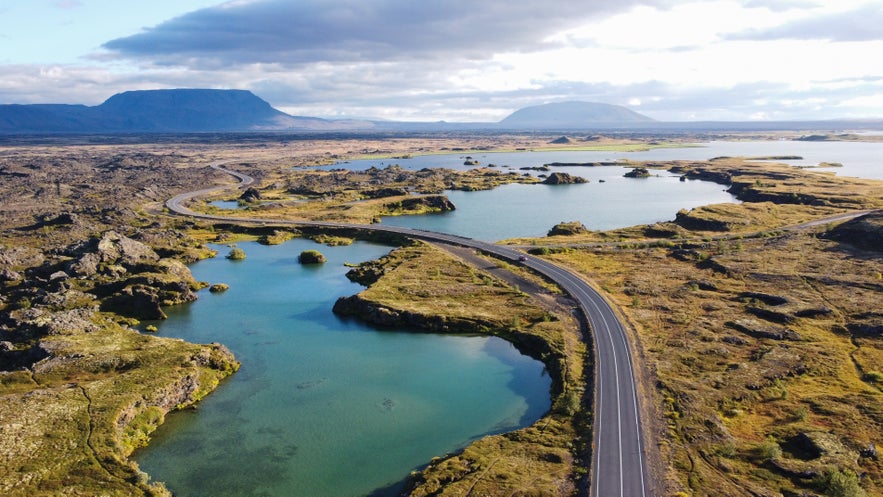 Dimmuborgir offers a captivating blend of geological wonder and rich Icelandic folklore. This "Dark Fortress" is a testament to the powerful forces that shaped Iceland's landscape, serving as the mythical home of Yule Lads and other intriguing figures.
Dimmuborgir offers a captivating blend of geological wonder and rich Icelandic folklore. This "Dark Fortress" is a testament to the powerful forces that shaped Iceland's landscape, serving as the mythical home of Yule Lads and other intriguing figures.
Dimmuborgir promises a unique and memorable experience. A visit to this mystical site is an essential part of any journey through North Iceland, inviting you to step into a world where nature and myth intertwine. Discover more of the many must-see places in North Iceland, along with the more hidden destinations in the region.
